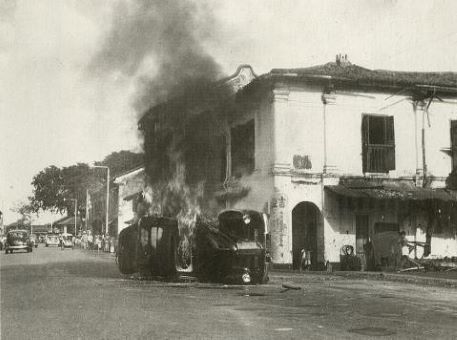In June 1948, the Communist Party of Malaya (CPM) launched an armed insurrection to overthrow the government through violent revolution and establish a communist state in Malaya, including Singapore. A state of Emergency was declared in Malaya and extended to Singapore. During
the 12-year conflict, the CPM carried out numerous acts of violence, including assassinations and grenade, arson and acid attacks, resulting in the deaths or injury of over 8,000 civilians and security personnel.
In the 1950s, faced with declining support and having suffered heavy losses during its armed insurgency, the CPM stepped up its united front activities, which involved the infiltration and subversion of political parties, trade unions, student groups
and cultural organisations in Singapore. This led to rising labour and student unrest, strikes, protests, boycotts and riots, resulting in the deaths of innocent Singaporeans and security personnel.
In 1954, the CPM succeeded in instigating Chinese middle school students to oppose the introduction of the National Service Ordinance. A violent demonstration held in front of the Government House (Istana) led to clashes between the police and students.
The following year, a communist-instigated strike by workers of the Hock Lee Amalgamated Bus Company erupted into violent riots. Two policemen, a foreign correspondent and a Chinese student died in the incidents. More riots followed in
1956 involving workers and students. Joined by pro-communist workers, student protests and sit-in demonstrations culminated in riots which spread across the island, leaving 13 people dead and more than 100 injured.

Two communist agents were killed when a home-made bomb they were carrying in their car exploded prematurely.
(Source: Ministry of Home Affairs)
The Special Branch took prompt action to stop communist leaders and agitators from destabilising the country. By the mid-1960s, a series of security operations mounted by the Special Branch and its successor ISD had significantly crippled the communist
underground in Singapore – many of its leading members had been arrested or fled the country. But the CPM renewed its armed struggle in 1968, re-establishing guerrilla units in the Malaysian jungles and inspiring the emergence of underground
groups which perpetrated acts of violence and subversion in Singapore. The most active and militant group was the Malayan National Liberation Front (MNLF); it provided the CPM with manpower, funds, supplies and equipment (including ammunition and
military equipment), and was also behind a spate of arson attacks and bombing incidents in Singapore in the 1970s. In one incident in 1970, a young girl was killed by a booby-trapped bomb planted by MNLF elements. In June 1974, a senior MNLF cadre
sent to Singapore to take over its operations and form an armed unit here was caught with a pistol, bullets, explosives and detonators. That same year, two members of another communist underground group, the Malayan National Liberation League, were
killed when a home-made bomb they were carrying in their car exploded prematurely at the junction of East Coast Road and Still Road. ISD intensified its efforts against the resurgent communist violence and subversive activities into the 1980s, and
succeeded in eradicating the communist threat in Singapore.
By the late 1980s, communism was on the wane. The fall of the Berlin Wall in 1989, and the collapse of communist regimes in Eastern Europe had eroded the credibility and appeal of communism. The CPM signed the Haadyai Peace Agreements with Malaysia and
Thailand in December 1989 to lay down arms and cease hostilities, marking the end of the communist insurgency in Malaysia.
Read more about the communist threat to Singapore; resources available at bookstores or the National Library:





